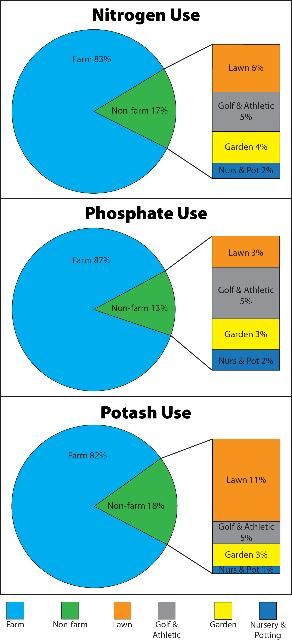The combination of Florida's diverse climate, agricultural production, and proximity to sensitive environmental habitats is unique to the southeastern United States. Nutrient applications are often required to meet the demand for agricultural and horticultural commodities. Because much of Florida is a peninsula, nutrient applications often occur in close proximity to water bodies and watersheds that feed ground water. In order for scientists, policy makers, and citizens to make informed decisions regarding nutrient issues in Florida, it is important to first understand which markets contribute to Florida's fertilizer consumption.
While the quantity of fertilizer consumed in Florida exceeds other states (except California, Illinois, and Texas) (EPA 2017), it is important to acknowledge several features unique to Florida. First, many crops grow year-round and, therefore, many farmers are able to achieve three crop rotations each year. Second, horticultural plants such as turfgrass, palms, woody ornamentals, and annual flowers also grow year-round and only exhibit slight decreases in growth during winter. Lastly, most Florida soils are primarily composed of sand, which has low nutrient retention compared to other high production agricultural soils, such as mollisols. For these reasons, it makes sense that nutrient applications in Florida would be greater than many other states.
The Florida Department of Agriculture and Consumer Services (FDACS) documents nutrient usage. According to the Florida commercial fertilizer law (Florida Statutes 576), all fertilizer companies must report fertilizer tonnage to the FDACS monthly. These data are collected and categorized as "farm" or "non-farm" market sectors. The farm sector comprises citrus growers, cattle ranchers, vegetable growers, etc. The non-farm sector includes nurseries, golf courses, home lawns, and gardens. After 2012, FDACS stopped receiving categorized nutrient data. Therefore, the most current nutrient use data is from 2012. Farm use was responsible for more than 82% of nitrogen (N), phosphate (P), and potash (K) consumption (Table 1 and Figure 1). Turfgrass (lawns + golf and athletic) consumed 11%, 8%, and 14% of N, P, and K, respectively; whereas, garden and nursery/potting soil constituted less than 6% of N, P, and K consumed in 2012.

Credit: FDACS 2017
According to section 502(14) of the Clean Water Act, nonpoint source pollution is defined as any source of pollution that does not meet the legal definition of "point source." Point source pollution is defined as any discernible, confined, and discrete conveyance, including but not limited to any pipe, ditch, channel, tunnel, conduit, well, discrete fissure, container, rolling stock, concentrated animal feeding operation, or vessel or other floating craft, from which pollutants are or may be discharged. Therefore, nutrient applications to soils and plants are not point sources of pollution, but may contribute to nonpoint source pollution. It is erroneous to assume that the difference in nutrient consumption between market sectors correlates with a particular market sector's contribution to potential nonpoint source pollution. Clear evidence identifying the N and P contributions to water bodies by market sector does not exist. Additionally, each market sector uses different percentages of soluble and slow-release materials, which differ in their ability to reduce nutrient losses to water bodies (Telenko et al. 2015). Evidence indicates that slow-release fertilizers greatly reduce the risk of nonpoint source pollution (Petrovic 1990), and, therefore, market sectors that utilize larger percentages of slow-release materials are likely to have less impact on nonpoint source pollution than markets utilizing soluble nutrient sources. However, until properly designed studies are completed, conclusions upon the market sector that contributes to N and/or P in Florida's water bodies cannot be made.
Summary
Florida's nutrient consumption reports serve as a foundation from which rational decisions can be discussed. Understanding nutrient consumption within the context of Florida's unique environment will help decision makers create more evidence-based solutions to Florida's current and future issues.
References
Environmental Protection Agency. 2017. Commercial fertilizer purchased. https://www.epa.gov/nutrient-policy-data/commercial-fertilizer-purchased (accessed March 21, 2017).
Petrovic, A.M. 1990. "The fate of nitrogenous fertilizers applied to turfgrass." J. Environ. Qual. 19: 1–14.
Telenko, D.E.P., T.W. Shaddox, J.B. Unruh and L.E. Trenholm. 2015. "Nitrate leaching, turf quality, and growth rate of 'Floratam' St. Augustinegrass and common centipedegrass." Crop Sci. 55: 1320–1328.